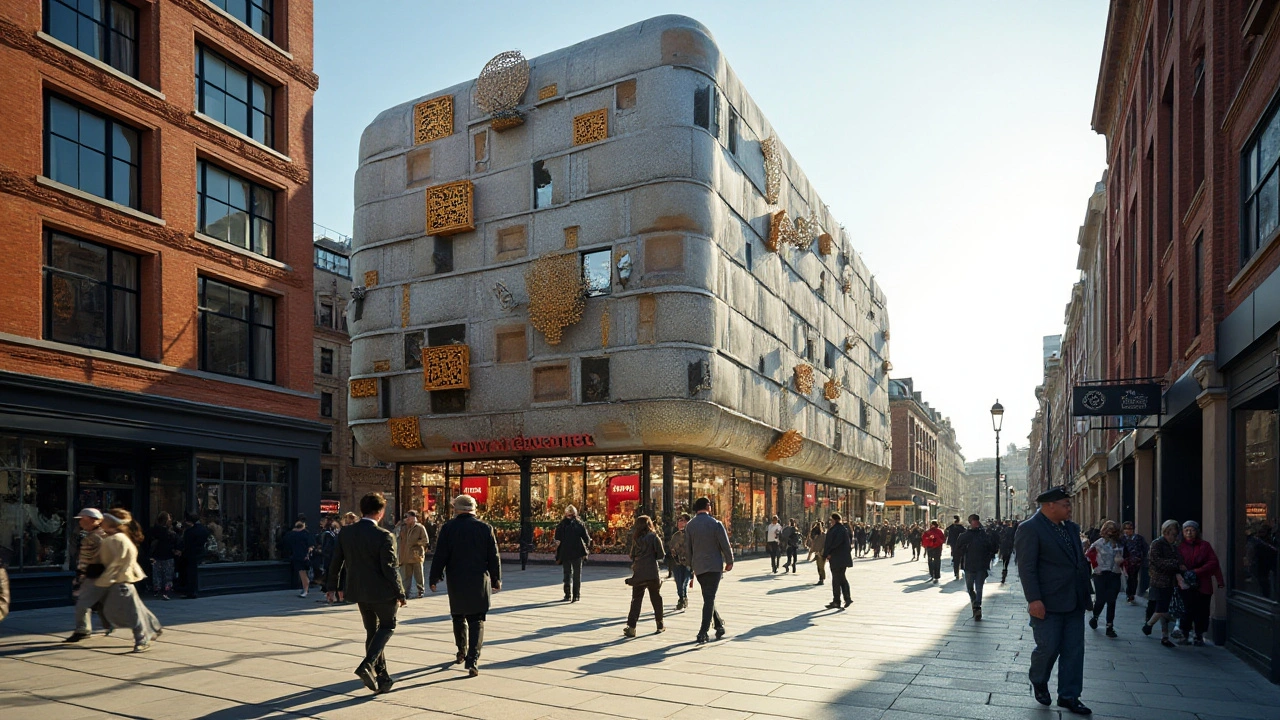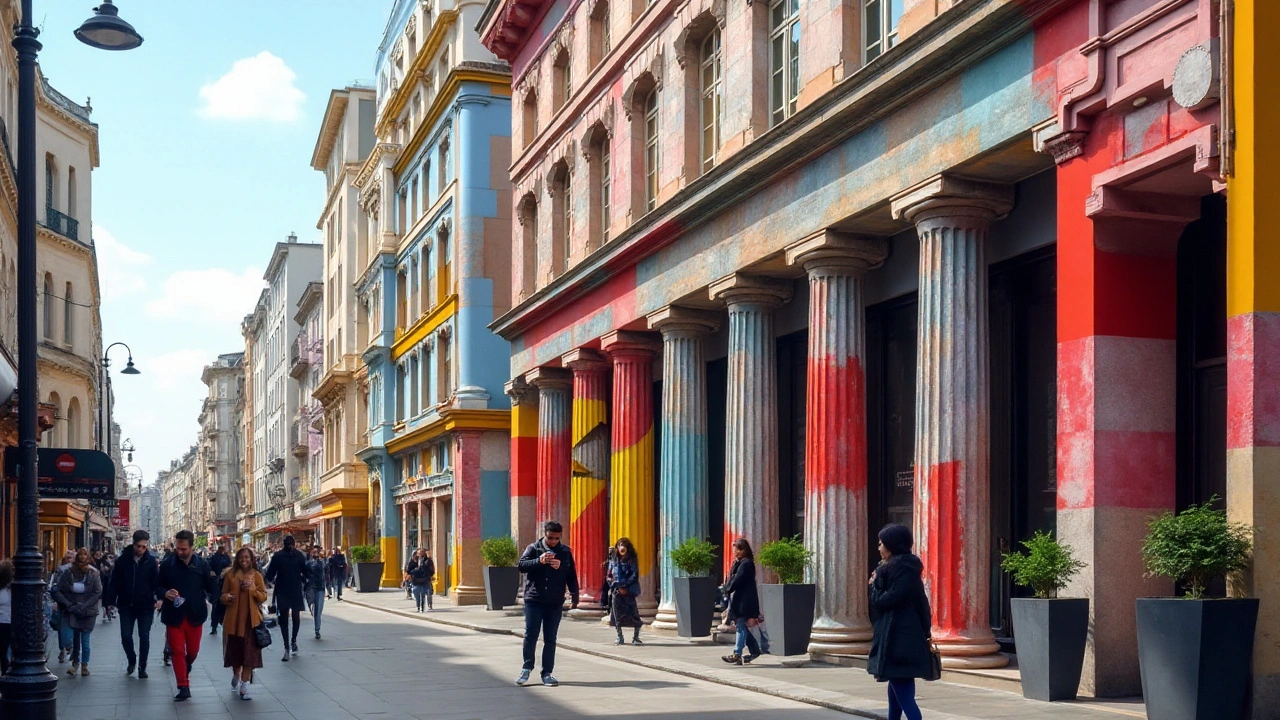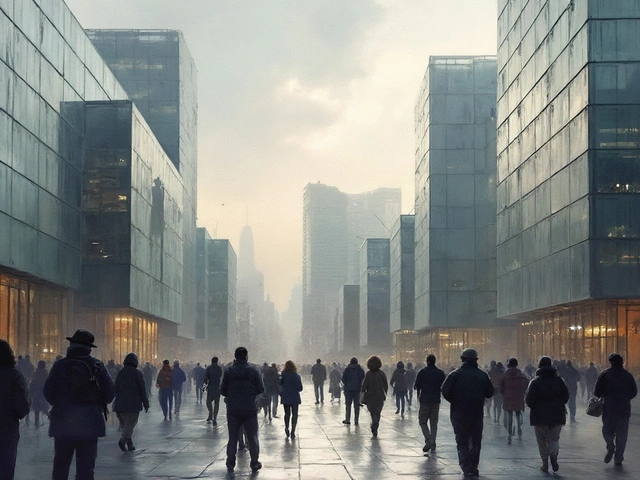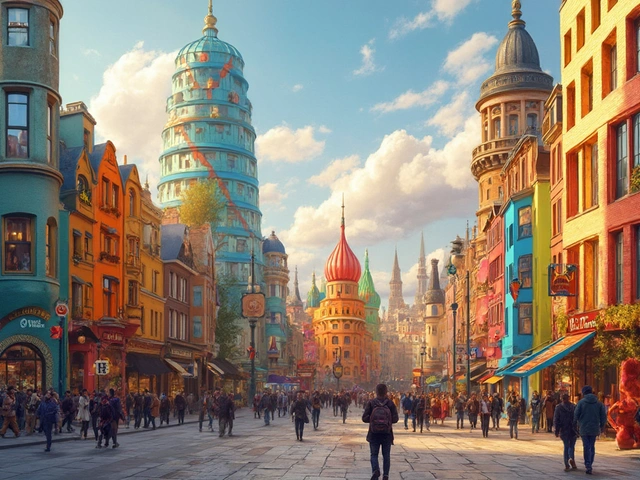Postmodern architecture, an intriguing movement that began to gain traction in the mid-20th century, challenges our perceptions of how buildings should look and feel. It dares to break away from the rigidity and formality of its predecessor, modernism, creating a more eclectic and vibrant architectural landscape. This style thrives on contradictions, historical wit, and visual whimsies.
Bringing together a diverse array of styles and references, postmodern designs are recognized for their use of bold shapes, vibrant colors, and unexpected combinations. It’s a celebration of individuality and a departure from the 'less is more' ideology that dominated previous years. By harnessing elements of the past, architects of this movement convey a sense of history while looking forward to the future.
So, whether it's the flamboyant forms or the thought-provoking use of materials, postmodern architecture continues to intrigue and inspire both the design community and the wider public, creating spaces that are as functional as they are fascinating.
- Origins of Postmodern Architecture
- Key Characteristics
- Influential Architects
- Iconic Postmodern Buildings
- Impact on Modern Architecture
Origins of Postmodern Architecture
In the years following World War II, a new architectural ethos started to take shape, leading to the emergence of what we now recognize as postmodern architecture. This movement was born as a reaction against the stark minimalism and perceived impersonality of modernist designs. Artists and architects wanted to move away from the clean lines and functional formality that modernism championed. The seeds of this design transformation were sown in the late 1960s, a time when societies around the globe were experiencing waves of cultural shifts and political upheaval. These changes encouraged a rethinking of how people viewed space and form. Those forward-thinking architects were determined not to be confined within the rigid frameworks their predecessors adhered to and began seeking more organic expressions in their work.
To understand fully how postmodern architecture developed, it helps to consider the broader socio-political landscape of that era. Many countries were undergoing a massive transformation in terms of industrial growth and urban aesthetics. This climate provided fertile ground for architects like Robert Venturi, whose work constantly questioned the less is more philosophy. Venturi famously stated, "Less is a bore," encapsulating the core philosophy of postmodernist ideals. The attraction of this new approach was its embrace of complexity and contradiction, offering buildings a chance to speak with multiple voices, reflecting intricate human experiences and cultural narratives.
The influence of the movement quickly spread across continents, as architects began integrating older styles and historical elements into their designs, yet with a twist. One could argue that the adoption of classic columns and ornate details, albeit in often ironic or exaggerated ways, gave a new fresh visual voice to urban landscapes. The resurgence of styles like neoclassicism and eclecticism within emerging urban areas was a vivid portrayal of this philosophical shift. At its core, postmodern architecture was all about storytelling through space, a factor that resonated well with both critics and the public alike, giving birth to structures that could proudly straddle the realms of art, history, and functionality.
Key Characteristics
At the heart of postmodern architecture lies a vivid interplay of styles and sensibilities, which serve as a departure from the uniformly balanced and function-focused essence of modernism. Postmodernism is marked by a colorful pastiche of references that span a rich tapestry of historical periods and cultural contexts. Its very core is filled with a spirit of rebellion against the monotony of steel, glass, and concrete. This architectural style embraces ornamentation, not as a frivolous afterthought, but as an integral narrative device that enlivens the built environment. Look closely at many postmodern structures and you'll notice that they embody humor and playfulness, often incorporating vibrant hues and eclectic forms that often defy traditional principles and expectations.
One of the defining features of this architectural approach is its commitment to diversity in form. Buildings crafted in the spirit of postmodernism frequently exhibit a mixture of shapes and sizes that seem to push boundaries and generate an air of unpredictability. Unlike the minimalist tenets of modernist buildings, which are often characterized by sharp angles and clean lines, postmodern buildings often feature curves, arches, and a myriad of unexpected details. These eccentric elements encourage viewers to ponder and engage, eliciting emotional responses and personal interpretations. Walls might incline at unusual angles, windows may take on irregular forms, and doors serve as decorative components in ways that challenge conventional expectations.
Another noteworthy aspect is the attention to contextuality. While modernism valued universality, postmodernism thrives on local references and storytelling, embedding narratives within its designs. Iconic structures within this genre often pull from an assorted palette of cultural markers, making each project a unique representation of its place and time. This inclusion of cultural narratives not only adds depth to a structure’s aesthetics but also forges a tangible connection with the surrounding community. Such is the case with the Piazza d'Italia in New Orleans, a whimsical architectural jewel that marries elements of Italian culture with modern American zest. Architect Charles Moore, who designed the plaza, once eloquently stated, and I quote, “We shape our buildings; thereafter, they shape us.”
The contrast plays an equally pivotal role. Many postmodern buildings experiment with juxtaposition, creating a vivid interplay between different materials, colors, and motifs. This contrast is often layered with irony and symbolism, with details conveying a deeper narrative or critique, urging observers to look beyond the facade. Think of the Portland Building with its futurist geometric forms coupled with traditional Greco-Roman elements. These aspects craft a striking visual dialogue that captures attention and sparks curiosity. This approach also extends to how interior and exterior spaces are conceived, with some structures offering an unexpected fluidity that blurs the boundaries between the two. The resulting impression is a harmonic, yet challenging balance that provokes discussion and thought.
This exploration wouldn't be complete without acknowledging the role of whimsical references in postmodern architectural compositions. From cartoonish motifs to exaggerated historical elements, these references build a whimsical lexicon that engages audiences across different spectrums and ages. This deliberate playfulness serves as a reminder of the architect's intent to challenge mundane perceptions and celebrate cultural diversity. Far from being chaotic, there is a meticulous and deliberate strategy behind these whimsical citations that enrich the stories whispered by postmodern buildings.

Influential Architects
In the dynamic world of postmodern architecture, several architects stand out for pushing boundaries and redefining what buildings could be. Among them, Robert Venturi is often cited as one of the pioneers. Venturi challenged the minimalist credo of modernism, advocating instead for complexity and contradiction. His book ‘Complexity and Contradiction in Architecture’, published in 1966, is considered a manifest of the postmodern movement. This piece of work calls architects to embrace diversity in design, incorporating historical elements in ways that had not been seen before.
Another key figure is Michael Graves, whose whimsical and colorful designs brought a playful vitality to architecture. Graves believed in creating spaces that were not only visually appealing but also accessible and inviting to people. One example of his work is the Portland Building in Oregon, which is often cited as one of the first significant structures of the postmodern era. Its staggered facade and playful use of color make it a standout, demonstrating how architecture can engage with its surroundings in more expressive ways. Graves’ work illustrates a shift towards buildings that tell stories, weaving cultural narratives into their form.
Frank Gehry is another name synonymous with postmodern architecture. Known for his experimental forms and innovative use of materials, Gehry’s designs often defy traditional classifications. His works like the Guggenheim Museum in Bilbao, with its curvaceous metal structure, have become iconic, both aesthetically and culturally. Gehry's approach often involves creating buildings that are sculptural, offering dynamic shapes that change with the viewer's perspective. This fluidity in design is a hallmark of postmodern thought, celebrating the unpredictable intersection of art and functionality.
A notable mention is Charles Moore, known for his vibrant use of color and texture that invite delight and intrigue. Moore's Piazza d'Italia in New Orleans stands as a testament to his ability to blend playful motifs with serious urban planning, showcasing vivid motifs inspired by Italian Piazzas. His work often played with scale and context, offering architecture that was community-focused and attuned to the human scale, qualities central to the postmodern ethos.
In the midst of these figures, we cannot skip mentioning Zaha Hadid. Although entering the limelight slightly later, her groundbreaking designs are clearly influenced by postmodern ideals, with a futuristic twist. Known as the 'Queen of the Curve', Hadid’s work, such as the Heydar Aliyev Center in Baku, challenges traditional orthogonal forms, creating fluid spaces that defy gravity and expectation. Her contribution to architecture is profound, as she merged artistic vision with technological advancements, pushing the boundaries of postmodern possibilities.
As Venturi famously stated, “Less is a bore,” encapsulating the spirited rebellion of the postmodern movement against the stark simplicity of modernism. This captures the essence of designs that delight in their abundance of forms, materials, and references rather than any hierarchy of beauty.
Together, these architects illustrate the rich tapestry of influences that define postmodern architecture. Their work does not only stand as functional spaces but as narratives of cultural engagement, artistic pursuit, and innovative expression. Each building becomes a statement, an embodiment of the era's quest to redefine and, at times, even mock, traditional notions of aesthetics and utility. Through these visionaries, the postmodern canon continues to inspire and evolve, demonstrating the endless possibilities within the architectural discourse.
Iconic Postmodern Buildings
When we dive into the world of postmodern architecture, one can't help but be captivated by the audacity and creativity that define its buildings. Think of the skyscrapers standing proudly in cityscapes, their silhouettes breaking the monotonous lines of the past with unexpected twists and playful designs. The AT&T Building in New York, designed by Philip Johnson and John Burgee, is a prime example. With its ornamental top resembling a Chippendale cabinet, the building challenges traditional skyscraper aesthetics through whimsical embellishments and historical references. Postmodern architecture shows that structures can be both functional and fun, celebrating a spirited rebellion against the formal constraints of modernism.
Diving deeper into this realm, we can't overlook the influence of the Portland Building by Michael Graves. Colorful and grand, its layered facades and small square windows make a bold statement about design freedom. The use of vibrant colors and symbolic motifs reverberates with an energy that seeks to humanize and enrich the urban experience. Graves blurred the lines between artistry and architecture, embedding an aura of storytelling into his work that can be felt walking through the halls today. It's as though the building itself speaks to us, sharing tales of the past with a contemporary voice, calling out to the passerby to stop and ponder its narratives.
Then there's the Vanna Venturi House, which may not boast the towering nature of a skyscraper, yet loses no ground in terms of impact. Designed by Robert Venturi, this house is often lauded as one of the first expressions of postmodern architecture. Its unconventional gable interrupted with an exaggerated arch and window arrangements turn heads and provoke thought. The residence reflects the ideology that architecture does not have to adhere strictly to one guiding principle but can be a joyful mashup of several inspirations. This freedom adds layers of interest for those who take the time to look beyond the surface.
At times, the appeal of postmodern architecture lies in its ability to generate discussions. Consider the Public Service Building in Portland, also by Graves, which has been subject to praise and criticism alike. Here, postmodernism flaunts its ability to engage the public consciousness, questioning not just what architecture is, but what it could be. Each element - be it color, shape, or material - is an invitation to explore and reflect on the built environment around us.
The late Charles Jencks once said, "Postmodern buildings are not just things to use but things to look at and wonder about, examples of our enhancing, creating capacity." Postmodern architecture kindles curiosity and conversation, celebrating human creativity above all.
Lastly, the Guggenheim Museum Bilbao, though more often associated with the Deconstructivist style, shares a spirit of whimsy with its postmodern counterparts. Its flowing design by Frank Gehry serves as a reminder of architecture's potential to excite and inspire imagination. With its undulating titanium forms, the museum breathes life into the waterside city of Bilbao, drawing visitors worldwide to marvel at its splendor. Through these iconic examples, postmodern architecture continues to challenge and redefine the horizons of spatial possibilities.

Impact on Modern Architecture
Postmodern architecture has significantly reshaped the landscape of modern design, introducing a more open-ended style that dismisses the strict uniformity of earlier architectural movements. Its impact can be observed in how current architects approach the blending of aesthetics, function, and history. By advocating for a balance between form and function, postmodernism has inspired architects to explore a greater diversity of design elements, leading to more expressive and meaningful urban landscapes. Postmodern architecture emphasizes the human experience within these spaces, encouraging designers to prioritize the lived experience while still delivering on the requirements of functionality and cost-effectiveness. As a philosophy, it has democratized architecture, encouraging design that is both accessible and extraordinary.
One of the key influences of postmodern design on contemporary architecture is the focus on contextualism. Rather than designing buildings in isolation, architects are now increasingly interested in how structures relate to their surroundings, incorporating local culture, history, and environment into their designs. This approach results in buildings that not only serve their purpose but also engage in a dialogue with the cityscape. The playful and dramatic aesthetics of postmodernism, such as the use of bold forms and vibrant colors, have heralded a new age of expressive architecture that embraces the idea of buildings as art.
Notably, the architect Michael Graves is renowned for his distinct postmodern style, influencing countless others with structures that are both whimsical and thoughtful. His design ethos not only honored the architectural past but also sought to reinterpret it, creating something entirely novel yet familiar. The versatility of postmodern ideas has fostered a spirit of innovation and prompted a resurgence of eclectic styles that resist the homogenized aesthetics once favored by modernist thinkers.
"Architecture should speak of its time and place, but yearn for timelessness." - Frank Gehry
Moreover, postmodern architecture has left a mark by pushing boundaries, inviting architects to ponder what constitutes beauty and function in their designs. Its playful defiance against convention advocates for creativity without abandoning classical sensibilities. Today, city planners and architects deploy elements of postmodern architecture such as mixed-purpose spaces and distinct public areas that stimulate interaction and community engagement. These are prime examples of how postmodern principles continue to fuel innovative practices in urban development. As architecture morphs with technological advances, postmodernism remains a touchstone, a reminder of the crucial balance between innovation and the preservation of our built heritage.





